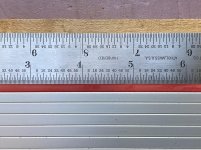cpw said:
When Sedge was demoing replacing them in one of the videos he used a Domino like a roller to really get pressure on the adhesive between the strip and rail.
I followed all of the best practices that have been shared on FOG when I replaced the splinter guards on 6 rails:
- removed all old adhesive with a solvent.
- let the rails thoroughly dry before attaching new ones ( i waited 2 days).
- bought a fresh box of splinter guard from the local rockler which had just restored their festool lineup after the long hiatus.
- used a roller to evenly and thoroughly apply pressure when attaching.
- clamped along the entire length of the rail using wood strips on top and bottom of the rail.
- applied clear shipping tape to the ends to help keep them in place.
- stored rails flat, horizontal, fully supported on piece of plywood suspended from ceiling.
My results: after one summer in the Pacific North west in a non-airconditioned space, the splinter strips all detached from the adhesive strip and separated from the rail in the middles. The ends were still attached to the rail with the packing tape. The adhesive that comes on the splinter guard was still attached to the rails. :-X
Conclusion: Environmental factors, such as Temperature swing, Humidity, and Min and Max temperatures really have more impact on the anti-splinter strips than has been accounted for in its current iteration. And from what I observed, it’s the interface of the plastic strip to the current adhesive that is the weak spot.
Any adhesive experts out there, please chime in with a good alternative to what Festool is currently using.


